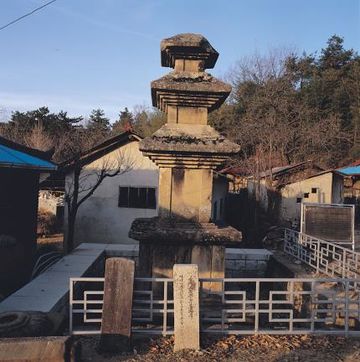진주 묘엄사지 삼층석탑
| 진주 묘엄사지 삼층석탑 Three-story Stone Pagoda at Myoeomsa Temple Site, Jinju |
|
 진주 묘엄사지 삼층석탑, 국가문화유산포털, 문화재청. |
|
| 대표명칭 | 진주 묘엄사지 삼층석탑 |
|---|---|
| 영문명칭 | Three-story Stone Pagoda at Myoeomsa Temple Site, Jinju |
| 한자 | 晉州 妙嚴寺址 三層石塔 |
| 주소 | 경남 진주시 수곡면 효자리 447-1번지 |
| 지정(등록) 종목 | 보물 제379호 |
| 지정(등록)일 | 1963년 1월 21일 |
| 분류 | 유적건조물/종교신앙/불교/탑 |
| 시대 | 고려시대 |
| 수량/면적 | 1기 |
| 웹사이트 | 진주 묘엄사지 삼층석탑, 국가문화유산포털, 문화재청. |
|
|
|
해설문
국문
진주 묘엄사지 삼층석탑은 고려 시대에 만들어진 것으로 추정된다. 2007년 이루어진 발굴 조사에서 ‘妙嚴寺(묘엄사)’라는 사찰의 이름이 새겨진 기와 조각이 발견되었다. 주변에서 불상과 승탑 등의 부재(部材)들이 여럿 발견되는 것으로 보아 당시 절의 규모가 상당히 컸을 것으로 보인다.
이 탑은 2층의 받침돌에 3층의 몸돌과 지붕돌을 올린 형태이다. 머리 장식은 일부만 남아 있다. 각 층의 몸돌과 지붕돌은 각각 하나의 돌로 만들어졌으며, 몸돌에는 모서리 기둥이 새겨져 있다. 1층 몸돌의 한쪽 면에는 부처의 사리를 모신 공간이 있다는 의미로 문짝과 문고리 모양을 새겼다.
영문
Three-story Stone Pagoda at Myoeomsa Temple Site, Jinju
A pagoda is a symbolic monument enshrining the relics or remains of the Buddha. Although not all pagodas contain the true remains, they are nonetheless worshiped as sacred places that enshrine the Buddha.
This three-story stone pagoda is presumed to have been made during the Goryeo period (918-1392). During excavations conducted in 2007, shards of roof tiles inscribed with the name of the temple Myoeomsa were discovered in the vicinity of the pagoda. Many parts of Buddhist statues and stupas were also discovered in the area, indicating that the size of the temple was once very large.
The pagoda is composed of a two-tiered base, three sets of body and roof stones, and the remaining part of a decorative top. The underside of the roof stones are carved into four tiers, and the corners of the body stones are carved to look like pillars. There are a gate and padlock engraved on one side of the first-story body stone, symbolically indicating that the pagodas enshrine the Buddha’s relics.
영문 해설 내용
불탑은 부처의 유골을 모신 상징적인 조형물이다. 모든 탑이 진신사리를 모신 것은 아니지만, 부처를 모신 신성한 곳으로 여겨 신앙의 대상이 된다.
이 삼층석탑은 고려시대에 만들어진 것으로 추정된다. 2007년에 이루어진 발굴조사를 통해 탑 주변에서‘묘엄사’라는 사찰의 이름이 새겨진 기와 조각이 발견되었다. 불상과 승탑 등의 부재들도 주변에서 여럿 발견되는 것으로 보아 당시 절의 규모가 상당히 컸을 것으로 보인다.
탑은 2층의 기단, 3층의 몸돌과 지붕돌, 머리장식 일부가 남아있다. 각 층의 몸돌과 지붕돌은 각각 하나의 돌로 만들어졌으며, 몸돌의 모서리에는 기둥 모양이 새겨져 있다. 1층 몸돌의 한쪽 면에는 부처의 사리를 모신 공간이 있다는 의미로 문짝과 문고리 모양을 새겼다.
참고자료
- 문화재청 http://www.heritage.go.kr/heri/cul/culSelectDetail.do?VdkVgwKey=12,03790000,38&pageNo=5_1_1_0
- http://www.ohmynews.com/NWS_Web/View/at_pg.aspx?CNTN_CD=A0002403057&CMPT_CD=P0010&utm_source=naver&utm_medium=newsearch&utm_campaign=naver_news
- 최근 사진(2020) https://m.post.naver.com/viewer/postView.nhn?volumeNo=27665460&memberNo=23506&vType=VERTICAL
- https://blog.naver.com/mallarmel/221434112922
- 경상북도의 석탑 1, 국립문화재연구소 건축문화연구실, 문화재청, 2016.